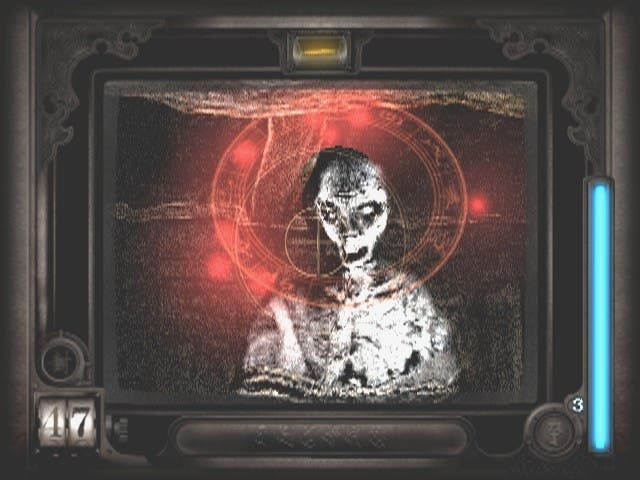Project Zero
Another terrifying horror game finds its way onto the PS2

Flashy visuals
Teenage high school student and part-time videogame heroine Miyu has ventured into the cursed Himuro mansion to try to find her brother, who disappeared without trace whilst filming a documentary. The prologue - shot in artsy high contrast black and white - shows roughly the events preceding Miyu's adventure, but obscures the conclusion to leave her brother's fate hanging in the balance. Throughout the game, the story of the brother and sister and the mansion's former occupants is told through the documentary team's scattered research notes and Miyu's supernatural flashbacks.
The game's first major departure from previous survival horror releases - particularly those from the Capcom stable - is that violence is hidden from you until after the fact, or seen through various graphical filters. Darkness also plays more of a role, with many rooms pitch black except for torches, moonbeams and Miyu's piddly flashlight, while the soundtrack is ambient and eerily unsettling. The darkness, awkward noises and implied threat are all very Alone in the Dark, but the real-time backgrounds of Project Zero and the Alien-esque school of fear-mongering through suggestion makes for a much more intelligent fright-fest.
Miyu's only weapon against the ghosts of the Himuro mansion is an old camera found early on, which can be used to kill (or at least vanquish) roaming spectres. Activating the camera gives you access to a first-person view, and the viewfinder highlights clues and acts as an aiming reticule. It also highlights once again the marginalisation of violence.

Snappy combat
This so-called combat is infrequent, and usually pits you against a convincingly translucent enemy who must be snapped, having been held in the viewfinder for as long as possible to charge up the 'attack'. Looking like extras from a Ghostbusters movie and zipping in and out of view, the ghosts are worthy adversaries and decidedly un-cute. Getting rid of a ghost is useful because he or she deposits spirit energy, which can be converted into a sort of spiritual currency to spend on improving your camera. This aspect of the game is somewhat unlikely, but it makes a nice gameplay addition, providing features like a faster charge rate, a larger viewfinder and special capabilities to your quasi-arsenal.
Project Zero also makes a bold impression with its changes to the control system. As with Resident Evil, Silent Hill et al, the camera switches perspective regularly, an action which confuses your control of the character, but Tecmo has managed to get round this problem to a certain degree by giving the square button the function of 'moving forward'. Whichever direction you find yourself facing on the screen, square takes you directly ahead, which, when coupled with strafe and 180-degree-turn functions, makes for a manageable game which is less frustrating to direct than it is to play. No more sliding along the walls for us!
Tecmo's Project Zero was released earlier in the year in the US, having made a successful start in Japan (both games were sold under the title Fatal Frame), and it should be released in September of this year by Wanadoo, at the cost of £29.99 - not bad going. It's a well-crafted adventure which gives PS2-owning survival horror fans annoyed by Capcom's decision to back the Cube pseudo-exclusively something to shout about. Or whisper about. The walls… they have ears.


